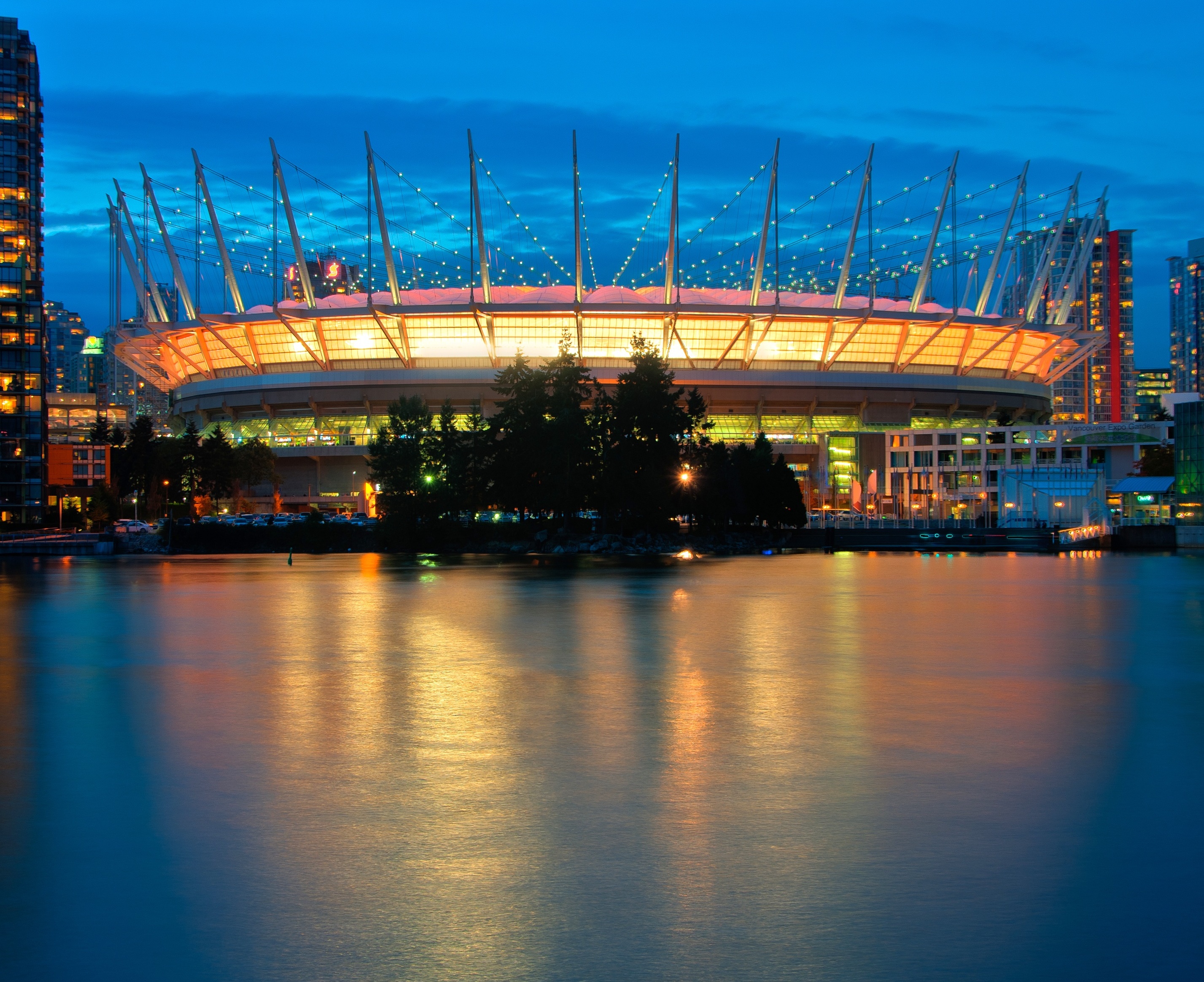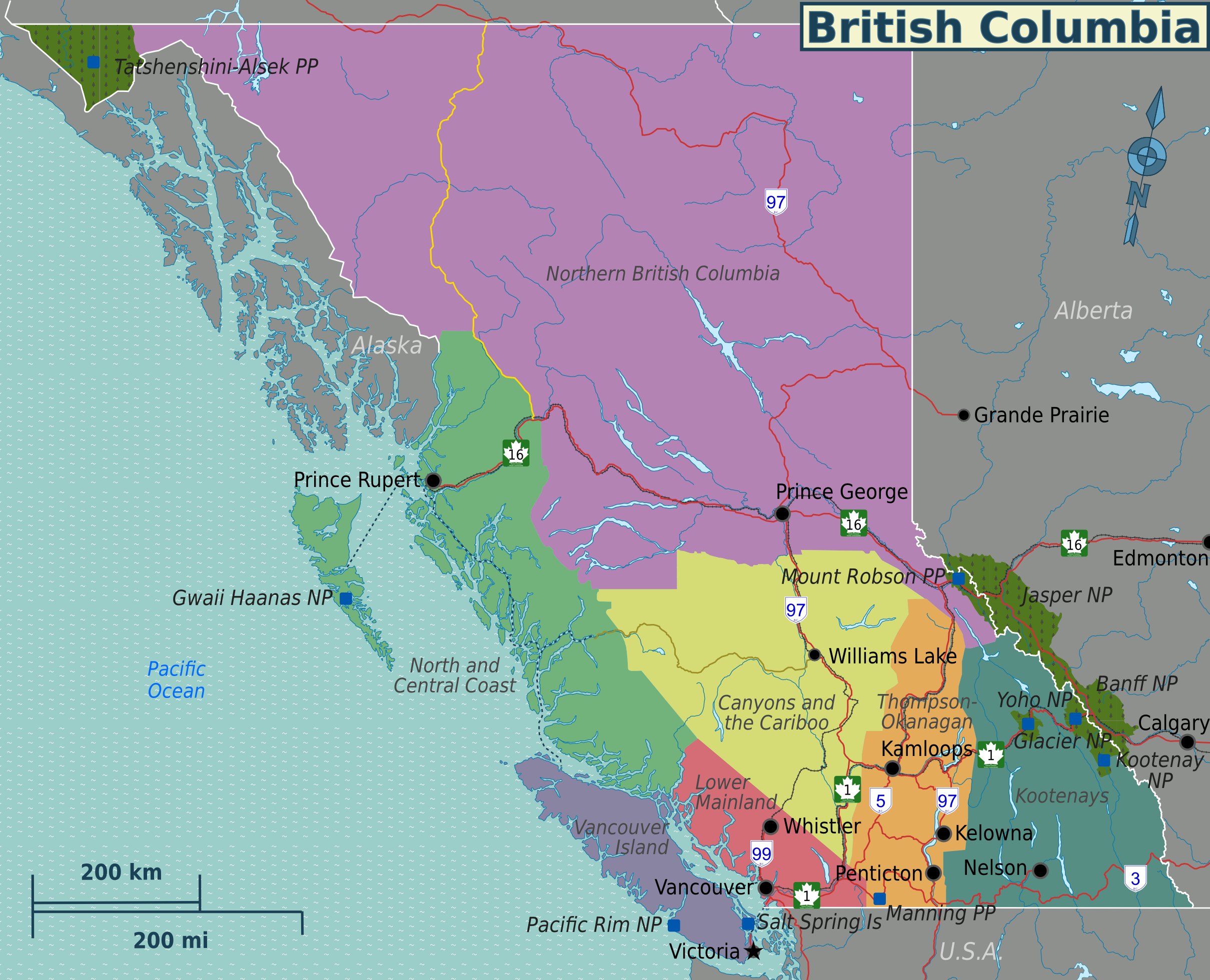B.C. Facts
Gateway to the Pacific
- British Columbia is the westernmost of Canada’s 10 provinces.
- Washington State, Idaho and Montana border B.C. to the south, Alberta to the east, the Northwest and Yukon territories to the north, and Alaska to the northwest.
- Click here for a map of British Columbia.

Official Symbols of British Columbia

British Columbia’s Provincial Flag
Adopted in 1960, the flag duplicates the design of the shield of arms of the province. Its proportion is five by length and three by width.
Adopted in 1960, the flag duplicates the design of the shield of arms of the province. Its proportion is five by length and three by width.

Spirit Bear – Provincial Mammal
The Spirit Bear (also known as the Kermode Bear) was added to the list of B.C.’s official symbols in April 2006. The greatest concentration of Spirit Bears can be found on the Central Coast and North Coast of British Columbia. The Spirit Bear is not albino, but rather it is a black bear that has white fur due to a rare genetic trait.
The Spirit Bear (also known as the Kermode Bear) was added to the list of B.C.’s official symbols in April 2006. The greatest concentration of Spirit Bears can be found on the Central Coast and North Coast of British Columbia. The Spirit Bear is not albino, but rather it is a black bear that has white fur due to a rare genetic trait.

Pacific Dogwood – Provincial Flower
The Pacific dogwood (Cornus nuttallii) was adopted in 1956 as British Columbia’s floral emblem. The Pacific dogwood is a tree that grows six to eight metres high and flowers in April and May. In the autumn it is conspicuous for its cluster of bright red berries and brilliant foliage.
The Pacific dogwood (Cornus nuttallii) was adopted in 1956 as British Columbia’s floral emblem. The Pacific dogwood is a tree that grows six to eight metres high and flowers in April and May. In the autumn it is conspicuous for its cluster of bright red berries and brilliant foliage.

British Columbia’s Coat of Arms
The shield of the province of British Columbia was originally granted by King Edward VII in 1906; the remaining elements of the Coat of Arms were subsequently granted by Her Majesty Queen Elizabeth II on October 15, 1987. The Union Jack on the shield symbolizes our colonial origins. Our geographic location between the Pacific Ocean and the Rocky Mountains is represented by the wavy blue and silver bars and the setting sun. The supporters, the stag and the ram, represent the former colonies of Vancouver Island and British Columbia. The royal crest (the crowned lion standing on the crown), wears a collar of dogwood flowers, and sits atop the golden helmet of sovereignty. Traditional heraldic elements of a wreath and mantling are in Canada’s colours. Our provincial flower, the dogwood, appears a second time entwining the motto which translates as Splendour without diminishment.
The shield of the province of British Columbia was originally granted by King Edward VII in 1906; the remaining elements of the Coat of Arms were subsequently granted by Her Majesty Queen Elizabeth II on October 15, 1987. The Union Jack on the shield symbolizes our colonial origins. Our geographic location between the Pacific Ocean and the Rocky Mountains is represented by the wavy blue and silver bars and the setting sun. The supporters, the stag and the ram, represent the former colonies of Vancouver Island and British Columbia. The royal crest (the crowned lion standing on the crown), wears a collar of dogwood flowers, and sits atop the golden helmet of sovereignty. Traditional heraldic elements of a wreath and mantling are in Canada’s colours. Our provincial flower, the dogwood, appears a second time entwining the motto which translates as Splendour without diminishment.

Steller’s Jay – Provincial Bird
The Steller’s jay (Cyanacitta stelleri) became the province’s official bird on December 17, 1987. Coloured a vibrant blue and black, it is found throughout the province. This lively, smart and cheeky bird was voted most popular bird by the people of British Columbia.
The Steller’s jay (Cyanacitta stelleri) became the province’s official bird on December 17, 1987. Coloured a vibrant blue and black, it is found throughout the province. This lively, smart and cheeky bird was voted most popular bird by the people of British Columbia.

Jade – Provincial Gemstone
Jade became the official mineral emblem in 1968. Consisting mostly of nephrite, B.C. jade is prized by carvers of fine jewellery and sculptures at home and particularly in the Orient. It is mined in many parts of British Columbia.
Jade became the official mineral emblem in 1968. Consisting mostly of nephrite, B.C. jade is prized by carvers of fine jewellery and sculptures at home and particularly in the Orient. It is mined in many parts of British Columbia.

Western Red Cedar – Provincial Tree
The western red cedar (Thuja plicata Donn) was adopted as the official tree of the province on February 18, 1988. Historically, the tree has played a key role in the lives of west coast aboriginal people, and continues to be a valuable resource for the province.
The western red cedar (Thuja plicata Donn) was adopted as the official tree of the province on February 18, 1988. Historically, the tree has played a key role in the lives of west coast aboriginal people, and continues to be a valuable resource for the province.

British Columbia’s Provincial Tartan
The provincial tartan has five colours, each with its own significance: blue for the ocean; white for the dogwood; green for the forests; red for the maple leaf; and gold for the crown and sun on the shield and flag. The tartan was adopted in 1974.
The provincial tartan has five colours, each with its own significance: blue for the ocean; white for the dogwood; green for the forests; red for the maple leaf; and gold for the crown and sun on the shield and flag. The tartan was adopted in 1974.

It’s Official
- B.C. entered Canadian confederation in 1871.
- Our provincial motto is “splendor without diminishment.”
- Our capital is Victoria on Vancouver Island.
- Steven L. Point was installed October 1, 2007 as British Columbia’s 28th Lieutenant Governor and the first Aboriginal person to hold the post.
- Our premier is Christy Clark, leader of the B.C. Liberal Party. She is the province’s 35th premier. Click here for a list of all the premiers of British Columbia, from 1871 to today.

People of British Columbia
- B.C.’s population was 4.405 million people as of December 2008.
- British Columbia is home to people of many different origins, cultural traditions, languages, ethnicities, and religions.
- B.C.’s aboriginal people are known as First Nations. There are 197 First Nations bands in the province, such as the Gitxsan, Haida, Nisga’a and Squamish.
- The top 10 languages spoken are now (according to the 2001 Census): English, Chinese (including Cantonese and Mandarin), Punjabi, German, French, Tagalog, Spanish, Italian, Korean, and Dutch.
- Each year, over 40,000 immigrants from around the world arrive in B.C.

One Big Province
- B.C.’s total land and freshwater area is 95 million hectares, larger than France and Germany combined. Only 30 countries are larger. British Columbia occupies about 10 per cent of Canada’s land surface.

The Great Outdoors
- B.C. has nearly 1,000 provincial parks and protected areas, attracting about 20 million visits every year.
- Since 2001, the provincial government has established 65 new parks, 144 conservancies, two ecological reserves and nine protected areas, and expanded more than 60 parks and six ecological reserves, protecting more than 1.9 million hectares (an area almost three times the size of Prince Edward Island.)
- This includes 200,000 hectares of habitat for the world-famous Spirit Bear, B.C.’s official mammal.
- Today, 14.27 per cent (or more than 13.5 million hectares) of British Columbia is protected – more than any other province in Canada.
- To find which provincial parks are closest to where you live, click here.
- To reserve a campsite online, click here.
- For more information about B.C.’s provincial parks, please visit: www.bcparks.ca.
Natural Resources
- British Columbia is Canada’s third-largest generator of hydro electricity, providing some of the lowest power costs in North America. The province is also Canada’s second-largest natural gas producer, and the oil and gas industry continues to see tremendous growth, particularly in north-eastern B.C.

People in Power
- The B.C. Liberals were elected in 2009.
- B.C. residents are represented by 85 Members of the Legislative Assembly (MLAs).
- Do you know who your MLA is? Click here to find out.
- Nationally, the 308-seat House of Commons and 104-seat Senate in Ottawa include 36 elected Members of Parliament (MPs) from B.C. and six B.C. senators appointed by the federal government.

Doing Business in British Columbia
- British Columbia is Canada’s gateway to the Asia-Pacific and is economically and geographically part of the northwest region of North America.
- While forestry, mining, fishing and agriculture remain important to B.C.’s economy, there is strong growth in new industries such as eco-tourism, agri-tourism, film and high tech.
- Our educational, transportation and telecommunications infrastructures are among the most modern in the world.
- Small businesses make up over 98 per cent of the province’s businesses, and now employ more than one million British Columbians. The Canada/British Columbia Business Service Centre has a variety of links to services for the B.C. business community. It also features an Online Small Business Workshop and an Interactive Business Planner.
- Over the last eight years, over 100 tax cuts have been introduced. As a result, B.C. now has some of the lowest taxes in North America.

Hollywood North
- British Columbia is the third-largest film and television production centre in North America – after New York and Los Angeles.
- The film industry is now a $1.2 billion industry in B.C. and directly employs about 35,000 people. Indirect jobs generated by the industry fuel the construction, tourism, and small business sectors.

Tourist Haven
- Tourism contributed $13.1 billion to the provincial economy in 2008, up 35 per cent since 2002.
- The most popular categories of tourism activity are outdoor recreation, city activities and visiting attractions and cultural events.
- For more information, visit Tourism B.C.

We’re Game
- B.C. was host to the biggest sporting event in 2010 – the 2010 Winter Olympic and Paralympic Games in Vancouver and Whistler.
- The Olympic are expected to generate over $4 billion in economic activity.
- Vancouver is B.C.’s biggest city and is home to the NHL Canucks. Other pro sports teams in the city include: B.C. Lions of the Canadian Football League, and a new Major League Soccer Franchise the Whitecaps.
- Over the last eight years, B.C. has developed an international reputation for sport hosting and have attracted, among other events, the:
- 2011 Grey Cup Championship
- 2010 World Wheelchair Rugby Championships
- 2009 World Police & Fire Games (Burnaby)
- 2008 North American Indigenous Games (Cowichan)
- 2008 World Women’s Curling Championships
- 2007 FIFA Under 20 World Cup Soccer
- 2006 World Junior Hockey Championships (Kamloops, Kelowna, Victoria & Vancouver)
- 2005 Grey Cup Championship (Vancouver)
- For more information on sports in B.C., visit http://www.hls.gov.bc.ca/sport/.




